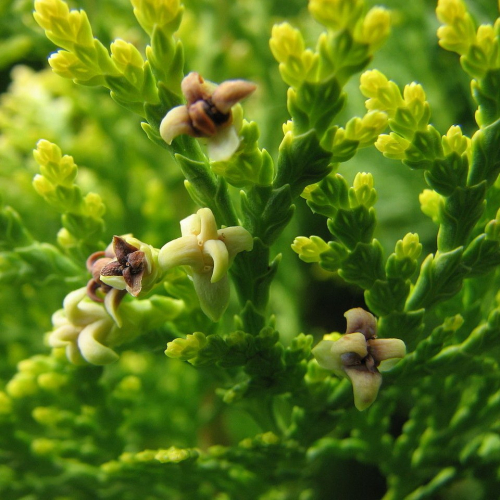Coniferous Platycladus

Description
Characteristic Features of Platycladus
Platycladus or Biota is a genus of evergreen coniferous trees that currently belongs to the cypress family Cupressaceae and contains only one species, Platycladus orientalis. Previously, the plant was included in the genus Thuja, so Platycladus is still commonly called Oriental Thuja (Thuja orientalis).
In the wild, Platycladus occurs in China, Korea, Japan, the Ukraine, and eastern Russia, where it is frequently found in mixed forests, mostly at higher elevations. Platycladus has been cultivated as an ornamental plant all over the world for many years. In China, this tree is believed to have powerful energy that promotes long life. No wonder the name of Biota means the "tree of life". In addition, Platycladus is a symbol of Beijing.
The plant does not have any specific requirements and is disease- and pest-resistant, which has made it popular in our latitudes. Currently, Platycladus can be found in every city park, outside office buildings, and in suburban areas. Trees planted in groups look great as hedges or borders and are perfect companions for other plants in rocky gardens. Platycladus is very attractive in single plantings. Some ornamental varieties are not hardy; therefore, they are frequently grown in containers, brought indoors for the winter, and kept in sunny locations at 5-15 ° C.
Platycladus has a shallow root system, a straight trunk or several trunks with a thin terracotta bark, and broad, fan-shaped, upright flat branches with yellow-red bark, making a cone-shaped crown. Mature trees have scale-like needles, while the young ones have pointed needles. It is noteworthy that green or golden needle colouring turns brown in the winter. Around April, very small yellow-green flowers can be seen on the shoots. The cones are spherical or oval. They are covered with blue-green patina when young and ripen brownish-red. The cone contains oval brown seeds, ripening in mid-autumn. The seeds and needles of Platycladus contain essential oil and are rich in vitamin C. They have long been used in medicine for the preparation of infusions and have soothing, antibacterial, antipyretic, haemostatic, and other properties. In addition, the trees release volatile oils that purify the air.
Platycladus growing in favourable conditions can sometimes reach a height of 17 metres. An average height is 5-10 metres. Platycladus growing in poor conditions often looks like a shrub.
Currently, there are about 60 ornamental Platycladus varieties varying in size, crown colours, and needle shapes.
'Aurea' is a heat-loving tree that reaches several metres tall and grows very slowly.
'Aurea Nana' is a dwarf tree that grows up to half a metre tall and has thin branches and small golden needles.
'Justynka' is a low-growing variety selected by Polish breeders, with a columnar crown and deep green needles.
'Cupressoidess' is a plant with a pyramidal crown.
'Blue cone' is a plant with blue-green needles and a topshaped crown.
'Meldensis' has bluish-green needles and a columnar crown.
'Pyramidalis aurea' is a relatively fast-growing tree with golden shoots.
'Elegantissima' grows up to 5 metres tall and has golden-brown needles and a topshaped crown.
'Magnifica' is a small tree (about 2-3 metres tall) with a topshaped crown and golden needles.
'Sieboldii' is a dwarf cultivar with a rounded crown and delicate pale green branches.
The Secrets to Successfully Growing Platycladus
This tree can grow in various climates. It is frost-resistant down to -25 ° C and drought-resistant; however, long periods of cold weather stunt the growth and make it less attractive. The plant thrives in open, sunny locations. Platycladus prefers lightweight poor soils and tolerates dry, rocky, and even salty soils; therefore, it does not need fertilizing. You can slightly fertilize young plants, though. Since this tree does not tolerate waterlogged soil, ensure good drainage. The basic care includes watering during the dry season, loosening the soil no deeper than 10 centimetres, and spring pruning (no more than one third of the shoots) to maintain the crown. Some varieties are not winter hardy and require sheltering with spruce branches, to be removed in April.
Platycladus is propagated by cuttings and occasionally by grafting. Platycladus species are propagated by seed. Multi-trunk trees can be propagated by division.
The seeds germinate well and do not require stratification. It is sufficient to pre-soak them for 10 hours. Sow the seeds indoors in containers with loose and moist soil in late winter or early spring. Prick out the seedlings into individual pots and plant out with a ball of soil to a permanent location the following spring. You can also sow seeds out directly in open ground in mid-spring.
Young cuttings that are planted in the autumn or spring root well. It is better to avoid using shoots of mature trees for propagation. Use such shoots for grafting into the thuja or cypress seedlings in the spring or late summer.
Because Platycladus grows slowly even in favourable conditions, seedlings from specialized nurseries are frequently used for landscaping. Plant them in the spring or summer, mulch with a 6 centimetre layer of peat or sawdust, and water well. Although Platycladus is drought-resistant, it needs to be watered once a week during its first two months and misted in the summer.
Potential Problems
Despite being disease- and pest-resistant (which is not true of the rest of conifers), Platycladus sometimes can get fungal diseases and aphids. Control with Fundazole and special insecticides.







 5 351
5 351








